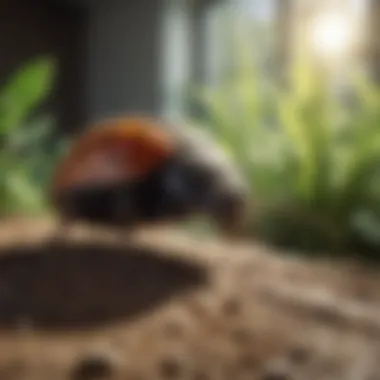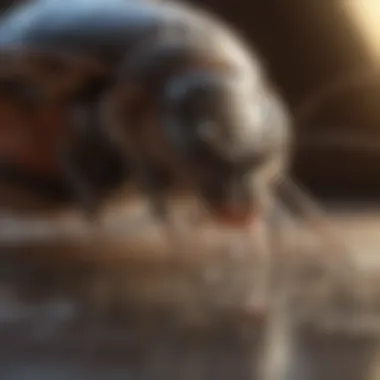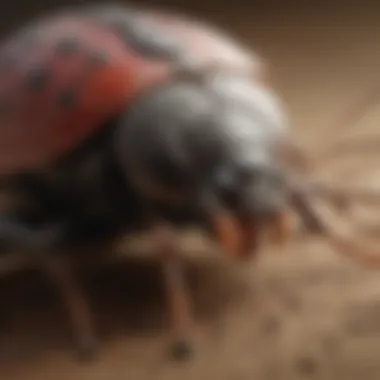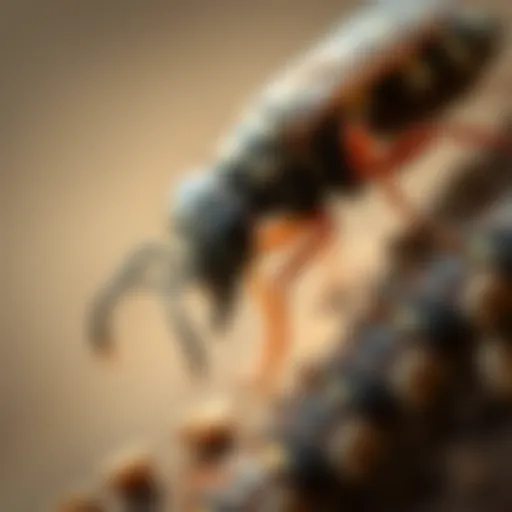Your Choice Pest Control: Strategies for Effective Management


Intro
Pest control management is an essential consideration for homeowners aiming to maintain a healthy living environment. Insects and rodents can disrupt daily life, causing damage and potential health risks. An effective pest control strategy involves understanding pest behavior, recognizing their signs, and applying appropriate control mechanisms. This article delves into comprehensive pest management strategies, offering practical insights for both homeowners and pest management professionals.
Understanding the Pest
Identification
To effectively combat pests, one must first accurately identify them. Different pests exhibit unique behaviors and triggers, which influence how they can be controlled. For example, ants often leave pheromone trails, guiding others to food sources. Cockroaches prefer dark, moist areas. Knowledge of these signs is crucial for targeted interventions. Tools such as visual guides or apps can aid in quick identification.
Life Cycle
Understanding the life cycle of pests is equally important. Many pests reproduce rapidly, making it essential to address them quickly before they proliferate. For instance, mosquitoes undergo a four-stage life cycle: egg, larva, pupa, and adult. Focusing on disrupting their life stages not only provides a more thorough control strategy but also reduces the likelihood of future infestations.
Pest Prevention Strategies
Environment Modification
Environment modification is a proactive approach to pest control. Homeowners can begin by eliminating standing water, sealing cracks, and regularly cleaning areas prone to food debris. Maintaining garden areas and keeping vegetation trimmed can reduce hiding places for insects. Regular inspections of the home can help identify areas that need attention before pests become a problem.
Physical Barriers
Physical barriers can also be effective in pest prevention. Installing screens on windows and doors is a simple yet effective method to prevent insects from entering the home. Additionally, using traps for rodents can limit their access before they establish themselves. Regularly checking these barriers ensures they remain effective over time.
Control Methods
Chemical Control
Chemical control, while often a go-to method, should be approached with care. Selecting targeted pesticides minimizes risks to non-target species and the environment. For indoor pest issues, options such as boric acid and diatomaceous earth can offer more environmentally friendly solutions. Homeowners should always follow application guidelines to ensure safety and effectiveness.
Biological Control
Biological control involves using natural enemies to manage pest populations. This can include introducing beneficial insects like ladybugs to control aphid populations. This strategy offers a sustainable alternative to chemicals, supporting better ecosystem health. Engaging in local gardening networks may provide insights into effective biological pest control tailored to specific local conditions.
Effective pest management blends understanding, prevention, and control to create a sustainable living space.
Closure
By understanding the nuances of pest behavior, employing effective prevention strategies, and considering both chemical and biological control methods, homeowners can create a comprehensive pest management plan. The prospect of maintaining a pest-free home does not have to be daunting. With informed decisions and strategic interventions, achieving effective pest control is within reach.
Understanding Pest Control
Pest control is essential for homeowners to maintain a clean, safe, and efficient living environment. It encompasses strategies and techniques aimed at managing unwanted organisms that can cause harm to property, health, and overall quality of life. By grasping the fundamentals of pest control, individuals can develop a proactive mindset towards preventing and controlling pest infestations.
Understanding pest control means recognizing the diverse range of methods available for pest management. Each approach has its own merits and drawbacks. With proper knowledge, homeowners can inform their choices. The benefits extend beyond the immediate elimination of pests. Effective pest management can prevent the propagation of infestations, ultimately saving time and resources in the long run. Moreover, a comprehensive understanding allows for adaptation to specific situations and the integration of environmentally conscious practices.
Definition and Importance
Pest control refers to the regulation or management of a species defined as a pest. Its importance lies in protecting health, food security, and property. Pests can harbor diseases or introduce allergens into living spaces. Moreover, they can damage crops and structures, causing significant financial loss. Therefore, understanding pests and their behaviors is critical for everyone.
Types of Pest Control
Different types of pest control methods serve varied purposes. It is crucial to evaluate each method based on effectiveness and environmental considerations.
Chemical Control
Chemical control involves the use of chemical substances to eliminate pests. This method is one of the most widely recognized and used due to its efficiency. Pesticides are designed to target specific pests while minimizing harm to other organisms when applied correctly. The key characteristic of chemical control is its rapid action. This is beneficial for immediate relief and extensive infestations. However, overreliance on chemical methods can lead to resistance among pests and potential harm to beneficial species. Thus, it is essential to apply chemical control judiciously.
Biological Control
Biological control utilizes natural enemies of pests, such as predators or pathogens, to manage pest populations. This type of control is increasingly popular due to its sustainability. Its distinctive feature is the promotion of ecological balance, as it reduces the need for chemical pesticides. A major advantage of biological control is its minimal impact on non-target organisms. However, it requires patience and careful planning, as establishing a biological control system can take time to yield visible results.
Cultural Control
Cultural control includes practices that reduce pest establishment, reproduction, and survival. This method emphasizes changing farming or gardening practices to make the environment less favorable for pests. Its primary characteristic is its preventative nature. For example, crop rotation or adjusting watering practices can significantly mitigate pest issues. Cultural control is cost-effective and environmentally friendly, but it may require consistent effort and monitoring.
Mechanical Control
Mechanical control involves physical methods to remove or exclude pests. This can include traps, barriers, or manual removal of pests. Its notable feature is that it does not rely on chemicals, making it a preferred option for many homeowners. This method is particularly valuable for small infestations and is easy to implement. However, it may not be effective for large pest problems, and ongoing maintenance is necessary to ensure success.
Identifying Common Pests
Identifying common pests is crucial in the realm of pest control. It allows homeowners to understand the challenges they face and find effective solutions. Proper identification can significantly impact the success of pest management strategies. Recognizing species and their habits facilitates informed decisions. For instance, a specific pest may require a unique control method. Without this knowledge, it's easy to misapply treatment and exacerbate the issue.
Common Household Pests


Household pests can create nuisances and pose health risks. Identifying these pests is a critical step toward effective management.
Ants
Ants are social insects that often invade homes in search of food. Their ability to communicate and work together allows them to form large colonies. This characteristic makes them a prevalent household pest. Their key feature is their foraging behavior, which can lead them to kitchen areas and pantries. However, they also play a role in the ecosystem by aerating soil and decomposing organic matter. The disadvantage of ants is their sheer numbers, which can create significant infestations if left unchecked.
Termites
Termites are notorious for their wood-eating habits. They can cause severe structural damage to homes if not identified and treated early. Their key characteristic is their ability to digest cellulose, allowing them to thrive on wood products. This makes them particularly dangerous for wooden structures or furniture. An advantage is that early intervention can save homeowners from costly repairs. However, they often go unnoticed until extensive damage has occurred.
Rodents
Rodents, including mice and rats, are common indoor pests. They are known for their high reproductive rate and capability to spread diseases. A key aspect of rodents is their gnawing behavior, which can damage property and pose health risks. Their adaptability to various environments makes them a successful pest. Nevertheless, they can be beneficial for research in certain areas but pose a significant challenge when invading homes.
Flies
Flies, specifically houseflies and fruit flies, can become a nuisance in households. They are attracted to food and waste, which makes them common in kitchens. A significant feature of flies is their rapid reproduction cycle. This characteristic allows for quick population growth, leading to infestations. The downside is their role in transmitting diseases. However, flies are essential in pollination and serve a vital ecological role.
Garden Pests
In gardens, pests can hinder plant growth and reduce crop yields. Identifying garden pests helps in maintaining healthy plants.
Aphids
Aphids are small, sap-sucking insects that can infest various plants. They often form colonies on new growth, stunting plant development. A notable characteristic is their ability to reproduce rapidly. This can lead to large populations in a short time. While they can attract beneficial insects like ladybugs, they can also transmit plant viruses. Managing aphids involves monitoring and using natural predators or insecticidal soaps as needed.
Caterpillars
Caterpillars are the larval stage of moths and butterflies. They can devour leaves, flowers, and stems. Their significant characteristic is their voracious appetite, which can lead to considerable damage in gardens. While they contribute to biodiversity as future butterflies, their rapid feeding can stress plants. Control methods often involve handpicking or using organic pesticides.
Spider Mites
Spider mites are tiny arachnids that damage plants by feeding on sap. A key characteristic is their ability to thrive in hot, dry conditions. They can cause leaves to appear speckled or discolored. Due to their small size, early identification is critical. While they can be controlled through increased humidity or the introduction of predatory mites, they can quickly devastate a garden.
Fungus Gnats
Fungus gnats are small flies that thrive in moist soil. They are known for their larvae, which feed on plant roots and organic material. A key feature of fungus gnats is their association with dampened conditions. While they typically do not pose severe threats, heavy infestations can weaken plants. Management strategies include letting soil dry out and using sticky traps to monitor and reduce numbers.
Behavioral Patterns of Pests
Understanding the behavioral patterns of pests is paramount in establishing effective pest control strategies. This knowledge aids homeowners and professionals alike in implementing more targeted interventions. By analyzing the behaviors, one can anticipate pest activities and make informed decisions regarding management techniques.
Feeding Habits
Feeding habits are crucial in comprehending pests because they influence where infestations are likely to occur. Various pests have distinct feeding patterns shaped by their biological needs.
For example, ants often seek sugary substances and protein, while termites consume wood and cellulose material.
Key Points about Feeding Habits:
- Identify pest diets to effectively bait or trap them.
- Assess household vulnerabilities, such as food storage.
- A well-maintained environment can deter feeding activities.
In summary, understanding what pests eat helps to develop preventative measures. It can also highlight sanitation practices, which are essential for reducing pest attraction.
Reproductive Behavior
Reproductive behavior also plays a significant role in pest control. Pests reproduce rapidly, which can lead to explosive populations. Knowledge about their reproductive cycles allows for better timing in intervention strategies.
For instance, knowing when mice or cockroaches mate can inform when to employ specific treatments.
Considerations about Reproductive Behavior:
- Monitor population levels to assess when control measures are necessary.
- Understand that breeding seasons may vary among species.
- Employ early interventions to disrupt their reproductive cycles.
By understanding these patterns, homeowners can take proactive steps rather than reactive measures.
Habitat Preferences
Lastly, the habitat preferences of pests provide insight into their behavior and movements. Pests are often selective about where they build nests or feed. Common habitats include kitchens, basements, and gardens.
Insights on Habitat Preferences:
- Identify potential nesting sites around your home.
- Knowing where pests thrive allows for better detection.
- Implement barriers to make habitats less inviting.
Choosing Your Pest Control Method
Choosing an effective pest control method is central to any pest management strategy. It involves a thoughtful and systematic approach to address pest issues in homes. This decision can significantly affect the outcome of pest control efforts. The effectiveness of control measures relies on properly assessing the situation and the specific needs of the home. It is prudent for homeowners to understand various available methods and tailor their approach based on individual circumstances.


Evaluation of Needs
Evaluating needs is the first step in selecting a pest control method. This involves observing the pest problem closely. Homeowners should detail what pests are present, their population size, and the areas they infest. Documentation helps in forming a clear picture of the situation. This contemplation leads to informed decisions.
- Identify the Type of Pests: Knowing whether the pests are insects, rodents, or other forms of infestations is critical.
- Determine the Level of Infestation: Understanding whether it is an early infestation or a more serious problem aids in assessing urgency.
- Assess the Location: Pests in kitchen areas may require different strategies than pests in the garden.
Risk Assessment
Risk assessment focuses on understanding potential hazards associated with different control methods. This is crucial for safeguarding residents and pets in the home. Factors to consider include:
- Health Risks: Some pest control methods involve chemicals that may pose health risks. It is vital to evaluate if these risks outweigh benefits.
- Environmental Impact: Methods should also consider environmental implications, particularly when dealing with chemical pest control.
- Resistance Development: Certain pests may develop resistance to specific treatments over time. Assessing the likelihood of this happening can inform method choice.
"Understanding the risks associated with pest control methods enables homeowners to make safer and more effective choices."
Cost Considerations
Cost is an important aspect when selecting a pest control method. Homeowners must balance effectiveness against their budget. Considerations include:
- Initial Costs: Some methods require a higher upfront investment while others may seem affordable but result in hidden costs.
- Long-term Expenses: Ongoing treatments can add up. It is wise to evaluate total projected costs over time.
- Economic Value: Sometimes the higher upfront cost leads to better effectiveness, saving money in future treatments or damage repair.
Integrated Pest Management (IPM)
Integrated Pest Management (IPM) is a versatile and strategic approach vital to effective pest management. IPM does not rely solely on chemical solutions; instead, it combines different practices and methods to achieve long-term pest control. By focusing on sustainable techniques, IPM minimizes risks to people, pets, and the environment while effectively managing pest populations.
One key benefit of IPM is its adaptability. This approach allows homeowners to tailor pest management strategies based on specific pest problems, environmental conditions, and personal preferences. Importantly, it prioritizes understanding pest biology and ecology, which results in more targeted interventions. By employing IPM, households can reduce their reliance on harsh chemicals, supporting a healthier living space.
Principles of IPM
The principles of Integrated Pest Management revolve around a few core tenets. These principles guide the decision-making process involved in selecting and applying pest control methods.
- Prevention: The first principle entails preventing pest infestations before they occur. Homeowners can implement measures such as sealing entry points or maintaining clean environments.
- Monitoring: Regularly observing pest activity helps in making informed decisions about necessary interventions.
- Identification: Correctly identifying pest types is essential. Different pests require different management strategies.
- Control Methods: Utilizing a combination of control techniques, including biological, cultural, mechanical, and chemical methods, to manage pest populations without harming beneficial organisms.
These principles ensure that pest management is effective and environmentally conscious.
Implementation Steps
Implementing IPM requires a systematic approach, which can be broken down into several key steps:
Monitoring
Monitoring is crucial in IPM; it enables homeowners to assess pest activity and determine when action is necessary. This ongoing observation can involve visual inspections, setting traps, and utilizing data from home pest management systems. One key characteristic of monitoring is its proactive nature.
Monitoring is beneficial because it helps identify problems before they escalate, allowing for timely interventions. A unique feature of this step is that it relies on evidence, making it a data-driven approach to pest control. Advantages include improved targeting of pest interventions, while disadvantages may be the time and effort needed to conduct thorough monitoring.
Identification
Identification is another pivotal aspect of IPM, making sure pests are correctly recognized. Accurate identification ensures that the chosen methods are effective for the specific pest encountered. A key characteristic of identification is its reliance on knowledge of pest species and behaviors.
Its role is beneficial as it aids in selecting the right control measures, potentially preventing mismanagement. A unique feature is the use of available resources, like identification guides or mobile apps. One advantage is reducing unnecessary treatment costs, but a disadvantage is that it requires expertise to differentiate similarly looking species.
Decision Making
Decision making in IPM stems from the data collected through monitoring and identification. This step helps homeowners choose the most appropriate control measures for their particular situation. A key characteristic of decision-making is its strategic aspect; it considers several factors like pest population numbers and environmental impact.
It is beneficial because it supports informed choices, potentially enhancing the effectiveness of pest management efforts. A unique feature of this step is the consideration of economic factors alongside ecological ones. The advantages include a balanced approach to pest control, while disadvantages may stem from potential indecision when faced with multiple options.
Eco-Friendly Pest Control Solutions
The shift towards eco-friendly pest control solutions is driven by a growing awareness of the environmental impacts of traditional pest management methods. Homeowners are increasingly prone to consider eco-friendly alternatives, which not only protect their homes but also minimize harm to the surrounding ecosystem. Eco-friendly pest control methods prioritize safety for humans, pets, and beneficial organisms in the environment, fostering sustainable practices that align with broader environmental goals.
Natural Repellents
Natural repellents use substances derived from plants or other naturally occurring materials to deter pests. These options often include essential oils, vinegar, and garlic, among others. Some advantages of natural repellents are that they tend to be safer than synthetic chemicals, making them more suitable for households with children and pets. For instance, essential oils such as peppermint and eucalyptus have shown effectiveness against ants and spiders.
Homeowners can prepare and apply these repellents themselves, which can be both cost-effective and sustainable. However, the effectiveness of natural repellents may vary based on factors like pest species and environmental conditions. It’s essential to test them in small areas before full application, ensuring they meet the desired outcomes without unnecessary hassles.
Beneficial Insects
Beneficial insects play a vital role in sustainable pest control by naturally regulating pest populations. Ladybugs, lacewings, and predatory wasps are examples of beneficial insects that can help keep harmful pest numbers in check. This approach reduces the reliance on chemical pesticides and encourages a balanced ecosystem in gardens and green spaces.
Encouraging beneficial insects involves creating favorable habitats. Homeowners can plant diverse flora that provides food and shelter for these insects. Ultimately, fostering an environment that attracts such beneficial species can reduce pest outbreaks while maintaining a healthy garden. By understanding the role of these insects in the ecosystem, homeowners can make informed decisions on managing pests more naturally.
Sustainable Practices
Sustainable practices in pest control refer to strategies that focus on long-term solutions rather than quick fixes. These practices include regular maintenance, sanitation, and monitoring. By adopting methods such as encouraging biodiversity and proper waste disposal, homeowners can create an environment less conducive to pest infestations.


Important sustainable practices include:
- Integrated Pest Management (IPM): Combining different pest control methods for a comprehensive approach.
- Regular Monitoring: Checking for signs of pests helps catch infestations early, ensuring timely interventions.
- Minimizing Chemical Use: When chemicals are necessary, choosing eco-friendly options reduces environmental impact.
In summary, eco-friendly pest control solutions offer significant benefits while addressing the intricate balance of ecosystems. By employing natural repellents, encouraging beneficial insects, and implementing sustainable practices, homeowners can significantly enhance their pest management efforts while protecting the environment.
Common Challenges in Pest Control
Effective pest management is not without its difficulties. Homeowners face numerous challenges in ensuring their properties are pest-free. Recognizing these issues is vital for successful pest control strategies. Understanding common challenges helps in formulating effective solutions, whether one is dealing with ants in the kitchen or rodents in the basement.
Resistance to Treatments
One of the most pressing issues in pest control is the growing resistance to treatments. Many pests develop immunity against commonly used pesticides over time. This problem stems from the overuse of certain chemicals, which can lead to pest populations that are impervious to these treatments. To counteract this issue, it’s essential to implement varied pest control methods. Combining chemical treatments with cultural and mechanical approaches can enhance effectiveness.
- Regularly rotating pesticides can prevent resistance.
- It is also advisable to use products from different chemical classes.
- Monitoring pest populations helps to identify when resistance begins to develop.
By being proactive, homeowners can maintain effective pest control measures and minimize future infestations.
Seasonal Variations
Seasonal variations significantly impact pest activity. Different pests exhibit unique behavioral patterns based on the time of year. For example, many insects thrive in warm weather, while rodents often seek shelter during colder months. Understanding these seasonal changes is crucial for pest management.
*Spring and summer typically see an increase in insects like mosquitoes, ants, and termiteactivity.
- In contrast, fall and winter can bring rodents indoors in search of warmth and food.
Planning pest control efforts according to these seasonal patterns can lead to more effective intervention strategies. Homeowners should remain vigilant and adapt their strategies as seasons change.
Environmental Factors
Environmental factors also play a critical role in pest control challenges. Changes in weather, humidity, and even landscaping choices can affect pest populations. For instance, excessive moisture can create favorable conditions for fungi and pests like cockroaches. Likewise, overgrown vegetation might provide harborage for various insects and rodents.
- Maintaining a dry environment helps reduce pest habitats.
- Proper landscaping can eliminate areas where pests can thrive.
- Regular inspections of property help in identifying potential pest breeding spots.
Being aware of these environmental considerations is crucial for long-term pest management success.
Informed homeowners can better manage their properties by adapting their pest control strategies to address these challenges.
Regulatory Considerations
In the field of pest control, regulatory considerations play a crucial role. Understanding the legal framework surrounding pest management is important for homeowners and professionals alike. Regulations ensure the safety of actions taken against pests, protecting not only the people involved but also the environment.
Pesticide Legislation
Pesticide legislation governs the use, distribution, and application of chemical products in pest control. Different jurisdictions have their own laws that outline which chemicals can be used and under what conditions. Homeowners should be aware of these rules to ensure compliance and safety. Among the key points of pesticide legislation are:
- Registration Requirements: Chemicals must be registered before use. This process verifies their efficacy and safety.
- Use Restrictions: There are often limits on where and how certain pesticides can be applied, especially in sensitive areas like schools and daycare centers.
- Labeling Standards: Products must have clear labels that inform users of hazards, instructions, and safety measures.
Compliance with pesticide legislation helps prevent misuse and protects the health of everyone involved, including pets and beneficial organisms in the ecosystem.
Safety Protocols
Safety protocols are designed to minimize risks during pest control operations. These protocols provide guidelines for safe handling, application, and storage of pest management products. Incorporating robust safety measures is beneficial not only for pest control specialists but also for homeowners who might undertake DIY methods. Important safety protocols include:
- Personal Protective Equipment (PPE): Using appropriate gear such as gloves, masks, and eye protection to reduce exposure risks.
- Proper Application Techniques: Following the recommended application methods to ensure efficiency and minimize environmental impact.
- Emergency Procedures: Having a plan in case of accidental exposure or spills, including knowledge of first aid measures.
Safety in pest control is not just a legal requirement, it is essential for the health and wellbeing of all.
Implementing these protocols ensures a responsible approach to pest management. It protects individuals, property, and the surroundings effectively. By understanding both pesticide legislation and safety protocols, homeowners can engage in informed pest management practices.
Future Trends in Pest Control
The realm of pest control is continuously evolving, driven by advances in technology and an increasing commitment to environmentally sustainable practices. Understanding future trends is paramount for homeowners. Adopting these trends can enhance pest management effectiveness while minimizing risks to health and the environment. In this context, staying informed about the innovations and research can empower house owners and professionals alike to make more informed decisions.
Technological Innovations
Technological advances are at the forefront of the future of pest control. Smart technology applications, such as the deployment of IoT devices, are set to revolutionize how pest management is handled. These devices can monitor pest activity in real time, providing instant data and notifications to the homeowner or pest control professional.
- Remote Monitoring: Using sensors, one can remotely monitor where pests are Active. This visibility aids in identifying problem areas sooner.
- Automated Traps: These devices not only capture pests effectively but also reduce human intervention. Some advanced models can even notify users when a pest has been trapped.
- Drones: In larger areas like farms, drones can survey agricultural fields to locate pest infestations quickly. This can dramatically reduce the response time needed to address an outbreak.
These innovations not only improve efficacy but also provide safer methods that minimize chemical exposure. Investing in such technologies can lead to more sustainable pest control practices in residential settings.
Research Developments
Research is instrumental in shaping the future landscape of pest management. Ongoing developments focus on understanding pest behavior and biology, which in turn leads to more strategic control methods.
- Genetic Studies: Scientists are looking into genetic engineering techniques to develop pest-resistant crops. This could reduce the need for chemical treatments and create a more balanced ecosystem.
- Biorational Pesticides: Development is underway for pesticides derived from natural sources that are less toxic than traditional options. These products can effectively target specific pests without harming beneficial species.
- Behavioral Studies: Comprehensive research into pest behavior patterns is crucial. Understanding why pests are drawn to certain areas can support better management strategies.
"Investing in research not only aids in pest control but also leads to educated strategies that minimize environmental impact."
These developments emphasize the need for a scientific approach to pest management, where research translates to practical solutions for house owners. The integration of knowledge and technology fosters an environment where effective management is not just reactive but proactive.
As pest control continues to adapt and improve, understanding and implementing these trends becomes essential for maintaining safe and healthy living environments.







